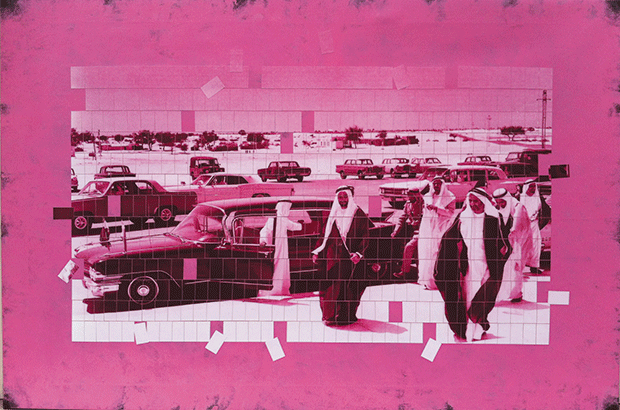
There’s an intrinsic link between location and artistic inspiration; humankind has striven to depict the environment (s)he perceives for as long as our species has turned to art as a form of expression. This remains true today, and many an artist — both resident and visiting — has drawn upon the UAE capital and what it represents.
“The UAE is a very interesting place,” says Swedish mixed-media artist Fabian Edelstam. “It’s a pioneer market, and the place to be.”
Earlier this month, Edelstam participated in the exhibition Nordic Outflight at the Fairmont Bab Al Bahr with his compatriot photographer Agneta Ekstrand, who studied photography at American University in Dubai and has lived in Singapore, Bahrain and Oman. The exhibition showcased stills and portraits, including many inspired by the UAE and its storied history.
One of his striking pieces, Zayed Motorcade, features the instantly recognisable picture of the nation’s founding fathers, the late Shaikh Zayed Bin Sultan Al Nahyan and late Shaikh Rashid Bin Saeed Al Maktoum. Taken out of its historic context, the piece is a bright pink mosaic, with the edges frazzled in an almost digital manner.
Turning back time
“I build bridges to the past and give new life to pictures that might have been forgotten,” Edelstam tells GN Focus in Dubai, where his work will be exhibited for the next month at D.tales on Jumeirah Beach Road.
“I was working on an exhibition on the 40th anniversary of the country’s unification, which presented a great opportunity to revisit history.
“Through collecting images from the early days of the UAE I’ve become fascinated with people like Shaikh Zayed and Shaikh Rashid, who were absolute visionaries who made the UAE what it is today. It was thrilling to get to work with these pictures, which capture the fantastic ambience of the time.”
By putting them in a pop art environment, the audience is invited to consider the image anew. But what looks modern actually has a long tradition. Edelstam has been working in digital art for about a decade, but the principles of mosaic date back centuries. The frazzling or disintegration along the edges and visible bonds between each small piece that makes up the bigger artwork draws upon both, but with a stronger motive. “The image is clear, but there are some holes, some missing pieces,” says the artist. “This is a metaphor for memory — when you recall something you could have a pretty clear image, but there are always some gaps.
“There’s also a psychological aspect. Art has the power to reconstruct, to recreate the universe.”
Alongside political figures, Edelstam creates portraits of other icons of a bygone era, including Motown act The Supremes and surrealist painter Salvador Dalí, captured at Le Bal Oriental — that lavish extravaganza in 1951 which is often called the party of the 20th century. This is juxtaposed with canvasses featuring modern celebrities such as Scarlett Johansson and Mick Jagger, and events such as the Abu Dhabi Grand Prix.
Landscapes reimagined
French photographer Isabelle Avenarius is inspired by the modern architecture in Abu Dhabi and its contrasting natural environment. Incidentally, she also works with photography and mosaic, shrinking the emirate’s skyline and landmarks, placing the images on tiles and creating unique mosaics.
Her manipulated photographs, featuring landmarks such as the Shaikh Zayed Grand Mosque, the Corniche, Marina and Khalidiya Palace will be on display at the Fairmont Bab Al Bahr from April 15-June 30.
Etihad Modern Art Gallery, meanwhile, also presents works directly inspired by the UAE and Abu Dhabi in the ongoing exhibition In This Place, featuring three artists.
“As the environment is my point of interest, Abu Dhabi is the subject of my paintings,” French painter Karine Roche tells GN Focus. “And even if people don’t appear in my paintings they are present, because they are the builders of this city.”
Roche says her work is about transcribing her perception of the UAE. In this sense, she uses bolder colours and contrasts to reflect the strong light here. “I also like to add fabrics to the canvas,” she says, “it makes for a new matter — close to a low relief.”
Soul matter
Artist Kim Robertson, who works with screen prints, likes to evoke a sense of place. “Abu Dhabi and the Emirates have had an enormous influence on my work, whether it be the culture of the people, the landscape or its history.
“The first drawings and photographs I took on arrival here six years ago were of Jebel Hafeet, which led to my first print, Wabi-sabi. Now, my love of the UAE landscape has led me further afield to the Hajar mountains.
“The kharareef or oral tales of the UAE have informed my series titled Folklore, and Khaleej Al Arabi street in Abu Dhabi was the inspiration behind my Non-place series.”
Robertson, who trained in textile design, borrows many techniques from fashion to create her works. “The pieces are quite minimalist and often produced in monochrome or duotone,” she says.
Bulgarian sculptor Svilen Petrov, who is Deputy Rector of the National Academy of Fine Arts in Sofia, works mainly with stone and bronze. His work harks back to the early years of modernist European sculpture, almost in contrast to contemporary trends. Some of his pieces that have a strong reference to Abu Dhabi include Wind Tower, Portrait and Heritage.
The artists and their work may be disparate owing to their different journeys and varying media, but they’re linked to each other and the wider community through a sense of being rooted in the Emirates.
A standout feature of this society is the juxtaposition of the old and new. “This mix is what gives the UAE its soul,” explains Edelstam, whose diplomat grandfather travelled here, thus introducing him to the country.
Perhaps presenting the Arabian culture of the past in a hyper-modern setting might be the best way to introduce the rest of the world to the UAE’s icons and its people.








